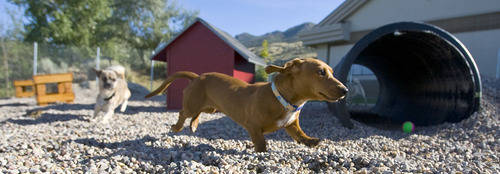This is an archived article that was published on sltrib.com in 2011, and information in the article may be outdated. It is provided only for personal research purposes and may not be reprinted.
Let the tail-wagging begin!
Dogs confined at the Davis County Animal Shelter now have the chance to get outside and frolic together in the facility's new 6,500-square foot play yard.
The fenced amenity — outfitted with sod, pea gravel, a six-foot tunnel, dog house, and small A-frame structure for shade — should not only boost the mental and physical health of the dogs but also enhance their adoptability, said Shelter Director Clint Thacker.
The $26,000 playground opened in early September, Thacker said, and was made possible through labor and materials donated by BOMA (Building Owners Managers Association) Charities.
"The dogs are exhausted after play," Thacker said. "They come back in and sit and chill in their kennels."
And that mellow demeanor makes them more attractive to prospective pet parents, he added.
"We're real excited about what we're doing here," Thacker said. "We're trying to make a difference."
Thacker is aiming at a no-kill target, similar to the philosophy of Salt Lake County's Animal Shelter where he served as supervisor from May 2009 to February 2011 before taking the helm of Davis's Animal Care & Control division.
Since 2008, Davis's euthanasia rates have declined from 70 to 50 percent, with cats making up 87 percent of the 1,685 adoptable animals put to sleep in 2011.
At capacity, the Davis County shelter can house 300 animals — and more in disaster situations, Thacker said. Of that total, about 130 are dogs.
"We're at maximum capacity and hold on to our dogs as long as we can," Thacker said of the shelter's present situation. Thacker said he fundamentally opposes euthanasia, but under current conditions the practice must occur almost daily at the Davis facility.
April Harris, spokeswoman for Salt Lake County's shelter, applauded Thacker's proactive efforts to save animals, adding that her facility has four play yards that have proved to be very beneficial.
"When people want to visit with the animal, they like to do it outside" — to better gauge a dog's behavior and temperament, Harris said. Also, someone who already owns a dog can test how it will interact with a new sidekick.
"We're also able to let big groups of dogs get out for enrichment," Harris said. That stimulation helps burn off their excess energy.
"It makes it so we can house them longer and they don't go crazy," Harris said.
While no-kill is the target — which means euthanizing so few that the practice is acceptable — Harris said her facility still performs that function about once a week for a variety of reasons.
"Our rates are 7 to 10 percent for dogs and 30 to 40 percent for cats" — 20 to 25 percent overall, Harris said. "We're probably at no-kill for dogs, but cats are trickier" due to their large and frequent litters. Extensive spay and neuter efforts are underway to reduce those numbers.
While the Salt Lake County facility can hold about 250 cats and 180 dogs, the shelter currently houses 660 animals, of which 420 are cats.
"We give up human spaces to save lives," Harris said of the dogs crated in staff offices and hallways, along with cats kenneled in disaster cages in the shelter's auditorium. "This is a happy place to be right now," she said.
Thacker hopes that Davis County commissioners can vote soon to lift the cap on the number of dogs residents can own per household and also to require cat licensing.
"Cats with ID — tag or microchip — have an 80 percent better chance of getting reunited with their owners," Thacker said.
Adoptable pets can be seen at the Davis County shelter, 1422 E. 600 North in Fruit Heights, from 9 a.m. to 6 p.m. Monday through Friday. For more information, call 801-444-2200.
twitter: @catmck —
Davis County euthanasia rates improving
As of mid Sept., the Davis County Animal Shelter has euthanized 213 dogs and 1,472 cats in 2011 — about 50 percent of the shelter's adoptable population. That number has dropped from 61 percent in 2010, 64 percent in 2009 and 70 percent in 2008.
Source: Shelter Director Clint Thacker









